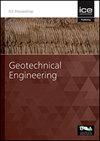An anchoring system for supporting platforms for wind energy devices
IF 1.7
4区 工程技术
Q3 ENGINEERING, GEOLOGICAL
Proceedings of the Institution of Civil Engineers-Geotechnical Engineering
Pub Date : 2023-07-25
DOI:10.1680/jgeen.22.00245
引用次数: 0
Abstract
This paper presents data from an initial development stage of an ‘umbrella anchor’ concept. The anchor can be pushed into sand deposit in a folded arrangement to reduce installation loads. When a pull-out load is applied to the mooring line, the anchor deploys to create a large embedded plate anchor. Physical modelling was carried out in saturated sand-bed with the anchor installed at depths of up to 1.6 m and loaded vertically. During installation, liquefaction was generated at the tip of the anchor to reduce the penetration resistance. This enabled the anchor to be installed quickly and accurately to a target depth. The anchor could provide pull-out resistances comparable to anchor that was wished-in-place at similar depths. The observed behaviour provided encouraging preliminary results and suggests that, with further development and analysis, the concept could potentially be used for commercial applications.一种用于风能装置支撑平台的锚固系统
本文介绍了“伞形锚”概念的初始发展阶段的数据。锚杆可折叠推入砂层,减少安装载荷。当拉出载荷施加到系泊线上时,锚会展开,形成一个大型嵌入式板锚。在饱和砂床中进行物理建模,锚安装深度可达1.6 m,垂直加载。在安装过程中,锚杆顶端会产生液化,以减小穿透阻力。这使得锚能够快速准确地安装到目标深度。锚可以提供与在相同深度的锚相媲美的拉出阻力。观察到的行为提供了令人鼓舞的初步结果,并表明,随着进一步的发展和分析,这一概念可能被用于商业应用。
本文章由计算机程序翻译,如有差异,请以英文原文为准。
求助全文
约1分钟内获得全文
求助全文
来源期刊
CiteScore
4.40
自引率
4.50%
发文量
68
审稿时长
3 months
期刊介绍:
Geotechnical Engineering provides a forum for the publication of high quality, topical and relevant technical papers covering all aspects of geotechnical research, design, construction and performance. The journal aims to be of interest to those civil, structural or geotechnical engineering practitioners wishing to develop a greater understanding of the influence of geotechnics on the built environment.

 求助内容:
求助内容: 应助结果提醒方式:
应助结果提醒方式:


